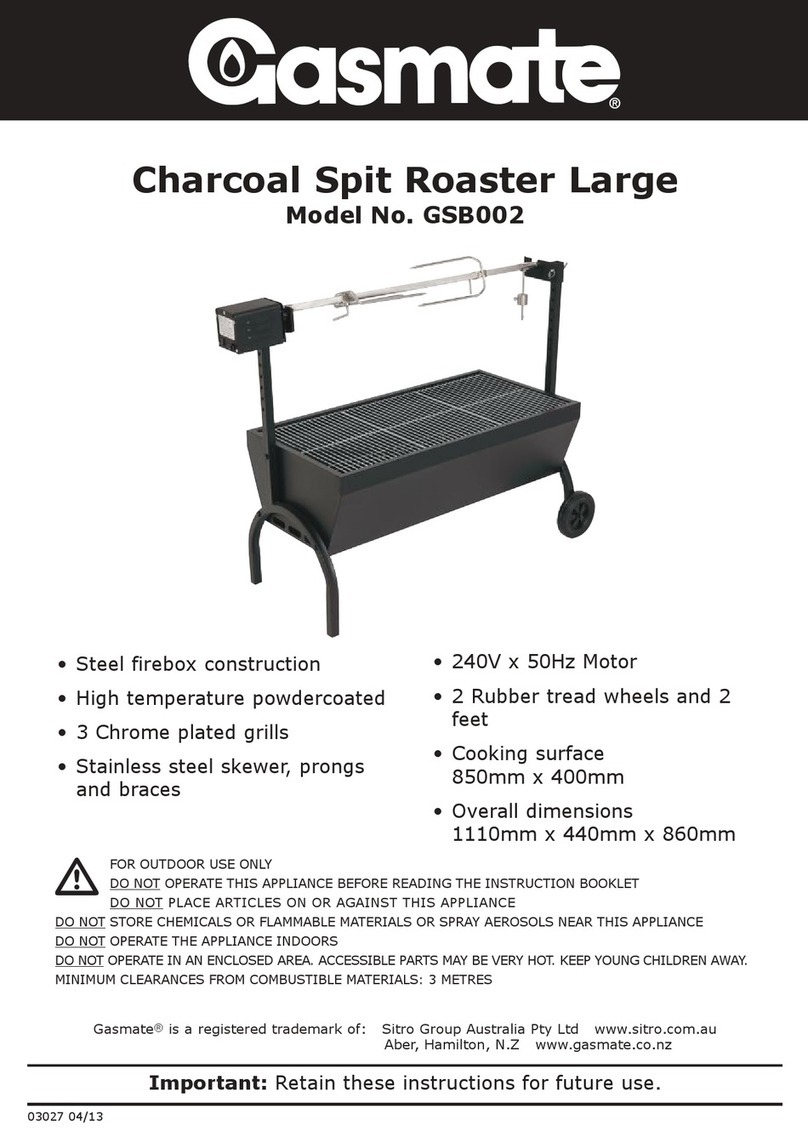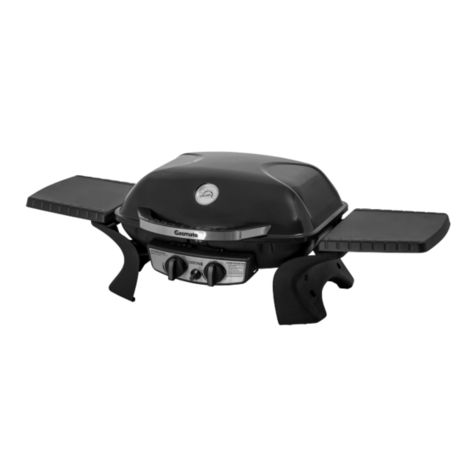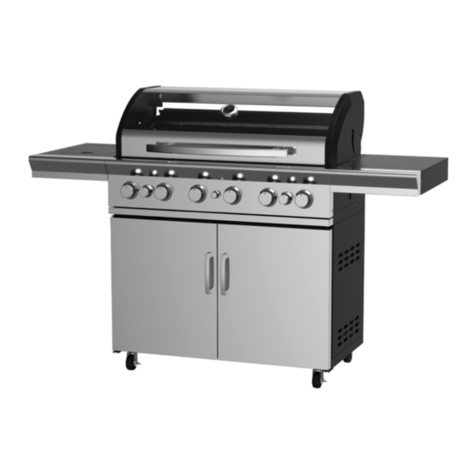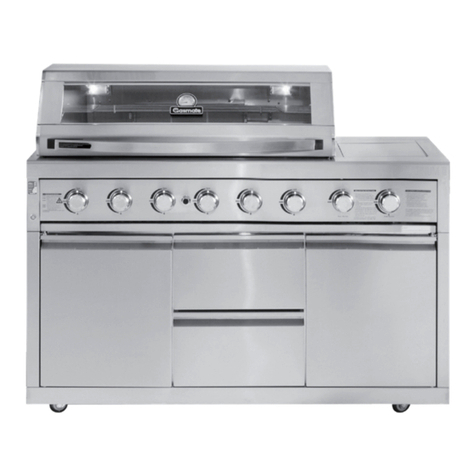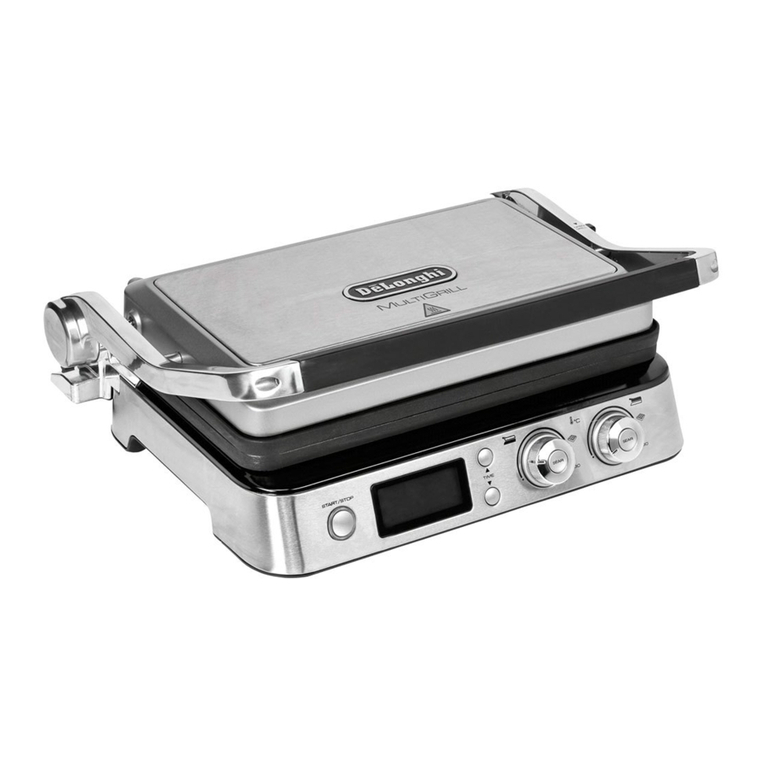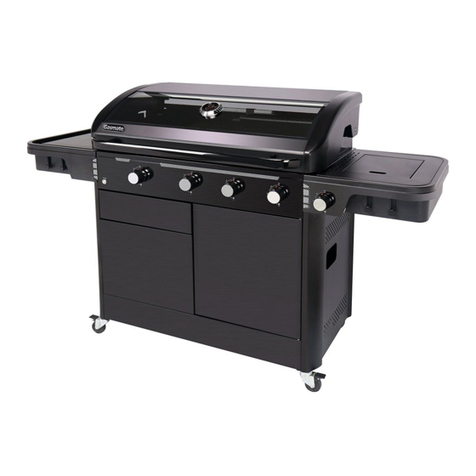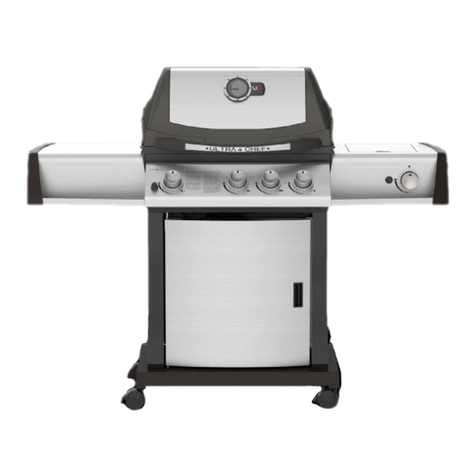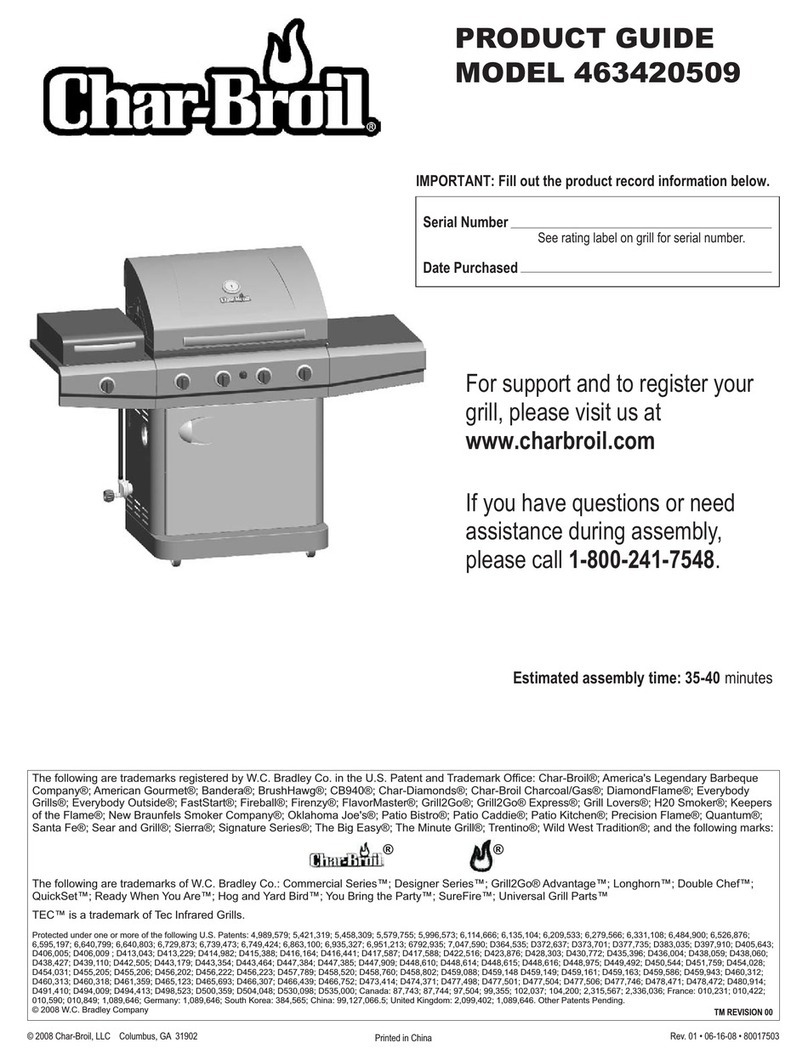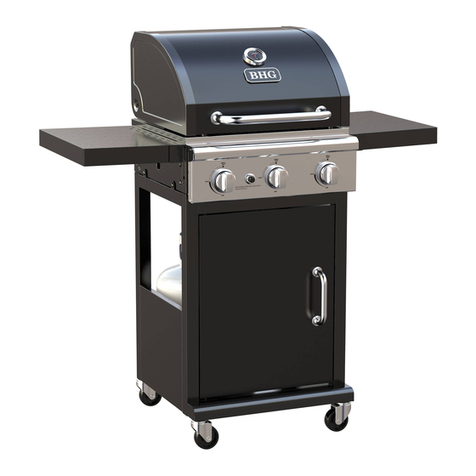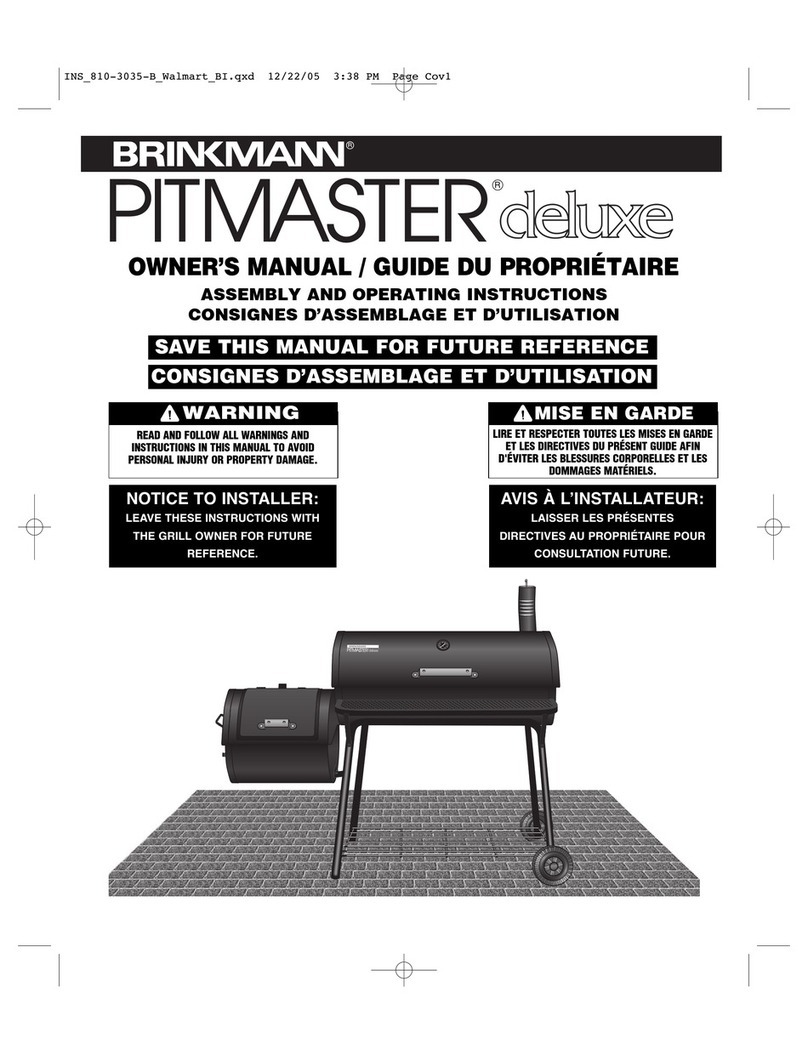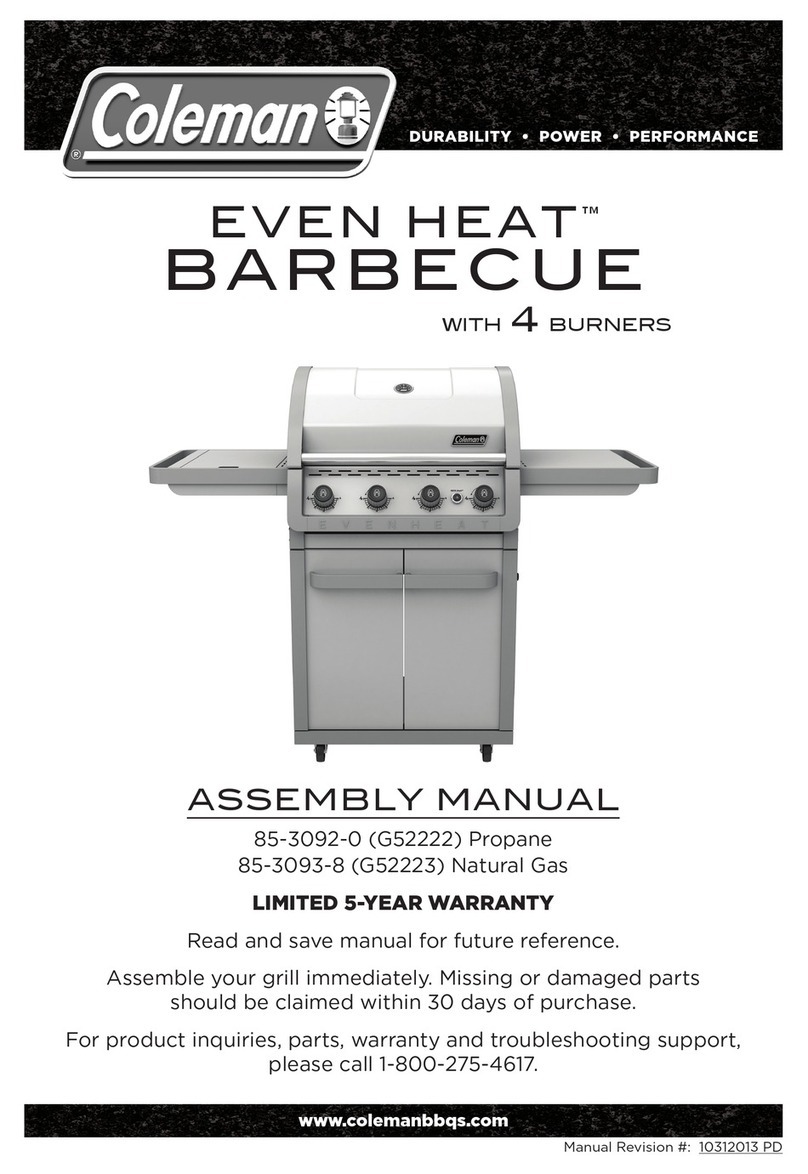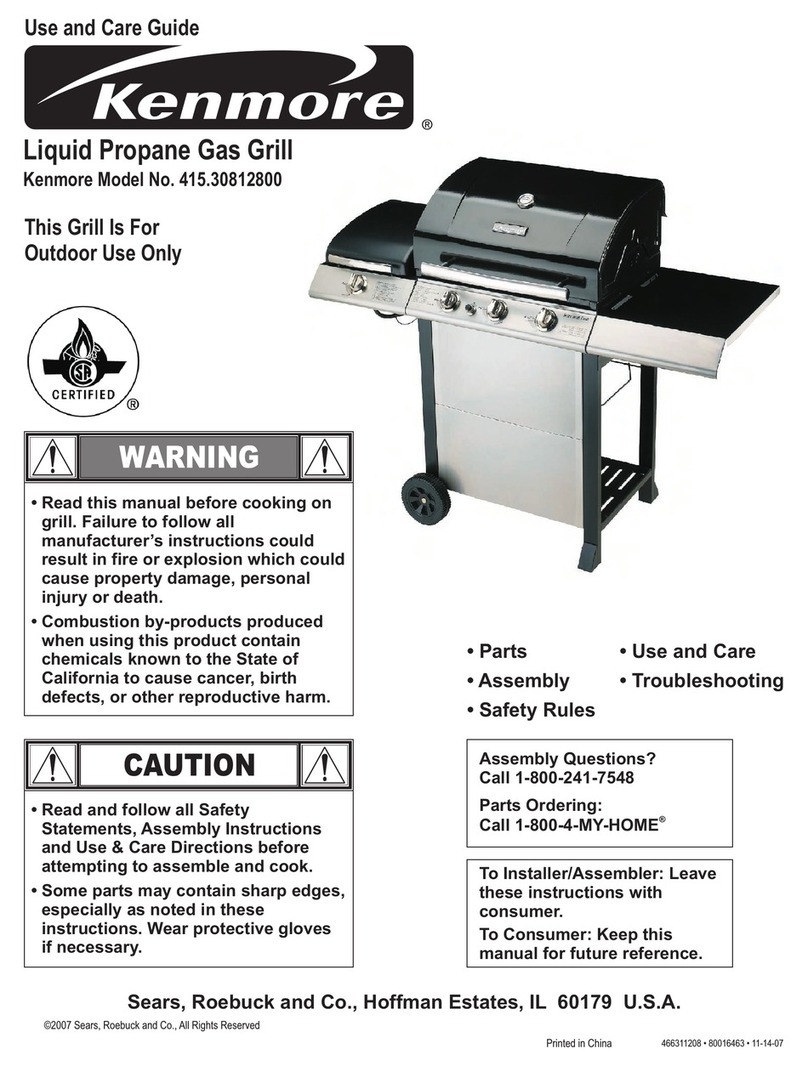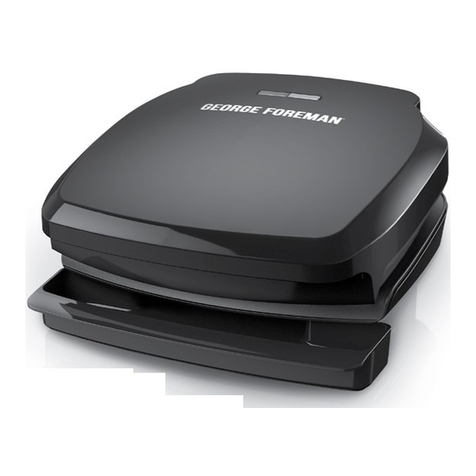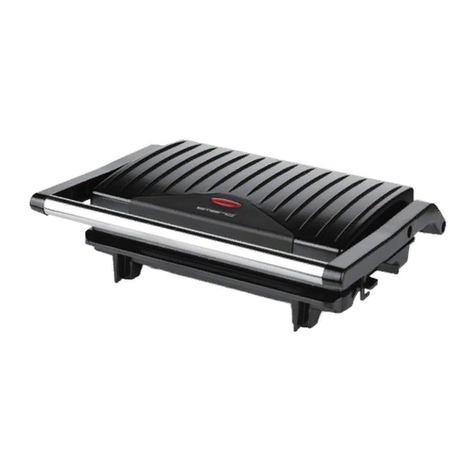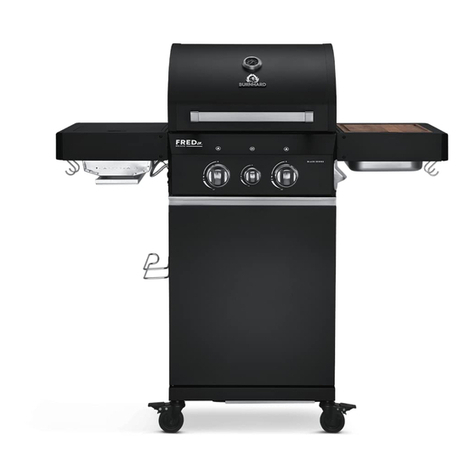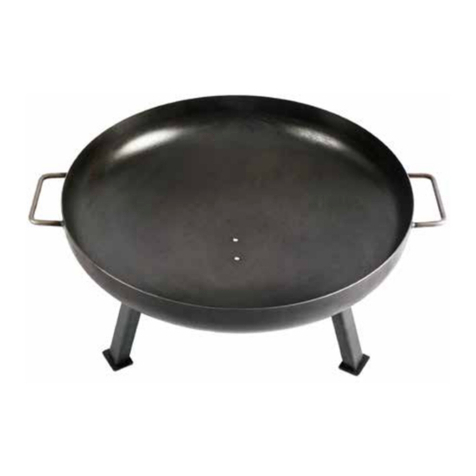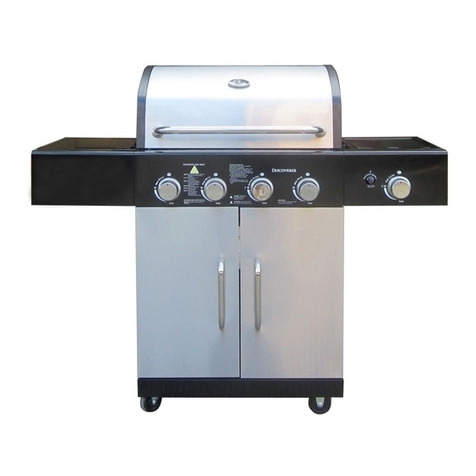Sitro Group ORION1 User manual

1
Model No. GM152-042
ORION1
PORTABLE BBQ
Important: Retain these instructions for future use.
Perfect for camping or alfresco cooking
12.6MJ/hr U-shaped stainless steel burner provides
even heat distribution
Hard-wearing porcelain enamel body and hood
Heavy-duty cast iron hot plate and grill
Piezo ignition for effortless lighting
Integrated temperature gauge for heat control
Easy access removable fat cup
Stand available as an optional extra (sold separately)
Supplied with hose and regulator so it’s ready to use
4926-06/18
Gasmate® is a registered trademark of: Sitro Group Australia Pty Ltd www.gasmate.com.au
Aber Living, Hamilton, N.Z. www.gasmate.co.nz

3
2
READ ME FIRST
GAS LEAK TESTING
It is important that you leak test the BBQ before first use and every time the gas cylinder is refilled and
reconnected to the BBQ.
To Complete Leak Test
• Make sure all the control knobs are OFF.
• In a small container, mix up a solution of water and detergent/soap.
• Mix the solution well (about the same concentrate as washing up water).
• Turn the cylinder ON by rotating the knob to open position.
• Using a brush or spray bottle apply the soap solution to the gas line and each join in the gas line including:
- the gas connection at the inlet of the BBQ
- all gas hose connections
- the gas connection at the gas cylinder
• If bubbles appear, there is a gas leak.
• If the leak is at the connection, re-tighten and re-seal.
• If the leak is anywhere else or you cannot resolve the leak by tightening the connection DO NOT PROCEED.
• Replace gas hose and regulator.
• Replacement hose and regulators can be purchased from your local BBQ retail specialist.

3
2
GENERAL INFORMATION
Gas Installation Codes
• Barbecues must be used in accordance with
New Zealand Standard 5601 “Gas Installations”.
• Barbecues for use with bottled gas are labelled
‘L.P.G’.
• Barbecues for use with natural gas are labelled
‘natural gas’ and must be installed by an authorised
person. Check the gas type sticker attached to the
barbecue.
Clearances
Minimum Clearances from combustible materials
must be:
Rear - 600mm Sides - 600mm Above - 1000mm
Specifications
Barbecue specifications can be found on the data label
attached to the barbecue body.
IMPORTANT
Read these instructions carefully prior to use.
Familiarise yourself with the appliance before
connecting it to it’s gas container. Keep these
instructions for future reference.
IF YOU SMELL GAS
1. Shut off gas to the barbecue at its source,
if possible.
2. Extinguish any open flame.
3. Open hood.
4. If odour continues immediately call your gas
supplier or fire department.
Hose & Regulator Safety
The regulator and hose assembly supplied with the
barbecue are suitable for L.P.G. only.
A gas regulator adjusted to have an outlet pressure of
2.75kPa is supplied for connection to the LPG cylinder.
The pressure regulator and hose assembly supplied
with the barbecue must me used. Replacement pressure
regulators and hose assemblies must be those specified
by the barbecue manufacturer.
When connecting the hose and regulator assembly to the
gas cylinder, take care to avoid unnecessary twisting of
the flexible hose.
After the assembly has been secured, turn on the gas
and check for leaks by brushing a soap and water
solution over all connections.
If you are unable to correct the leak by tightening the
connections, turn off the gas and contact the supplier
immediately.
Always ensure the barbecue is kept away from flammable
materials and the gas cylinder clear of any heat source.
When changing over from an empty gas cylinder to a
full one make sure this procedure is carried out in a well
ventilated location, preferably outside, away from people
and away from any sources of ignition; such as naked
flames, pilot flames, electric heaters/equipment.
Gas Cylinder Use & Safety
This is a low pressure barbecue and must only be used
with the regulator supplied. Your barbecue is designed
for use with 9kg LPG cylinders.
The gas cylinder should be filled by a reputable gas
supplier and visually inspected and re-qualified at each
filling.
Always keep cylinder in an upright position. Always close
the cylinder valve when the barbecue is not in use.
Do not subject gas cylinder to excessive heat.
NEVER STORE YOUR GAS CYLINDER INDOORS.
If you store your barbecue indoors, ALWAYS disconnect
the gas cylinder first and store the cylinder safely outside.
Cylinders must be stored outdoors in a well ventilated
area out of reach of children, and must not be stored in a
building, garage or any other enclosed area.

5
4
FOR YOUR SAFETY
Failure to comply with these instructions could
result in a fire or explosion which could cause
serious bodily injury, death or property damage.
CAUTION: Accessible parts may be very
hot.
Keep young children away.
DO NOT modify this appliance.
DO NOT move this barbecue during use.
Turn off gas supply at the gas cylinder after use.
Parts sealed by the manufacturer or their agent
must not be manipulated by the user. This barbecue
is only to be used and stored outdoors.
• Never operate this barbecue without a regulator.
• Do not test for gas leaks with an open flame.
• If this information is not followed exactly a fire
causing death or serious injury may occur. Do not
store a spare gas cylinder under or near this
barbecue. This barbecue is only to be used and
stored outdoors.
• If there is a leak on your appliance (smell of
gas) immediately attempt to turn off the cylinder
valve. Remove the appliance to a well ventilated
location away from any ignition source. Only
check for leaks outdoors using soapy water. DO
NOT try to detect leaks using a flame.
• Check for leaks by brushing a soap and water
solution over all connections. If you are unable to
correct the leak by tightening the connections,
turn off the gas and contact customer service
immediately.
• Only use the hose assembly as supplied with
this appliance for connection to the cylinder -
DO NOT USE ADAPTORS.
• Maximum hose length - 600mm.
• After use turn the gas cylinder valve off, wait
for the flame to go out, then turn the
appliance control valve off.
• Avoid twisting or kinking the flexible hose.
• Do not store or use petrol or other flammable
liquids in the vicinity of this or any other
appliance.
• Do not store empty or full spare gas cylinders
under or near this or any other appliance.
• Never test for gas leaks with a lit match or open
flame. Never light barbecue with hood closed or
before checking to ensure the burner tubes are
fully seated over gas valve orifices.
GENERAL INFORMATION
• Never lean over cooking surface when lighting.
• Never alter or modify the regulator or gas supply
assembly.
• This barbecue must not be used indoors.
• Only use in well ventilated areas.
• CARBON MONOXIDE HAZARD - USING THIS
APPLIANCE IN AN ENCLOSED SPACE MAY
CAUSE DEATH. DO NOT USE IN CARAVANS,
TENTS, MARINE CRAFT, CARS, MOBILE
HOMES OR SIMILAR LOCATIONS.
• This appliance shall only be used in an above
ground open-air situation with natural ventilation,
without stagnant areas, where gas leakage and
products of combustion are rapidly dispersed by
wind and natural convection.
• Ensure the barbecue is set up on a level and
stable surface.
• Do not move the barbecue while in use or when
hot. Remove the drip tray before moving.
• DO NOT replace the grill with an extra hotplate.
The warranty will be voided and it violates the gas
approval, the grill provides the ventilation needed
for the BBQ to operate safely. It is not designed
to be a solid hotplate device.
IF THERE IS A LEAK
• Turn the cylinder off.
• Ventilate the area to disperse gas.
• Check all connections.
• If leak persists, keep the cylinder upright. Keep
skin away from any gas or liquid escaping from
the cylinder.
• Keep the cylinder at least 20 metres away from
any sparks or ignition sources, including electrical
equipment, camera flashes, engines and motors.
• Disperse gas by encouraging maximum
ventilation and spraying with a fine water spray.
IF THERE IS A FIRE
• If the fire is at the barbecue, turn the gas off at
the cylinder. Smother the flames with a wet cloth,
fire blanket or extinguish using a fire extinguisher.
• If the fire is at the cylinder, or you can not get
to the valve to turn the gas off, contact the fire
brigade immediately.
• Using a garden hose, direct the water to the
middle of the cylinder to keep it cool. Try not to
extinguish the flame. At least if the gas is burning,
it won’t be able to build up pressure and explode.

5
4
Location of your Barbecue
DO NOT use your barbecue in garages, porches, sheds,
breezeways, or other enclosed areas. Your barbecue is to
be used OUTDOORS. The barbecue is not intended to be
installed in or on recreational vehicles and/or boats and
should not be placed under any surface that will burn. Do
not obstruct the flow of combustion and ventilation air
around the barbecue housing.
Protect Children
Keep children away from barbecue during use and until
barbecue has cooled after you have finished. Do not
allow children to operate barbecue.
Always ensure that no sporting or physical activities are
carried out in close proximity to the barbecue during use
and while still hot.
Tools You Will Need
Adjustable spanner, Philips head screwdriver.
Check Barbecue for any Damage
Inspect barbecue parts as you proceed. Contact your
supplier for assistance regarding replacement of any
damaged or missing parts. Do not assemble or operate a
barbecue that appears damaged. Barbecues for use with
gas cylinders are labelled ‘ULPG’. Check labelling at the
gas connection on your barbecue.
Nominal Hourly Gas Consumption
Main Burner
Gas Type I3B/P(30) ULPG
Inj. Size 0.93mm
Gas Cons. 12.6MJ/h
Gas Pressure 2.75kPa

7
6
EXPLODED DIAGRAM
HARDWARE
PARTS LIST
1 : 1PC 2 : 1PC
3 : 1PC 4: 1PC
5 : 1PC 6 : 1PC
7 : 1PC
Remove any transit protection material. Remove all
contents from the carton packaging. Make sure all parts
are present before attempting assembly.
Once the BBQ is fully assembled, go back and check to
make certain all the bolts are secure. Tighten again using
a screwdriver if necessary.
A : 2PCS B : 2PCS
ASSEMBLY INSTRUCTIONS

7
6
ASSEMBLY INSTRUCTIONS
STEP 1
Attach the hood handle as shown.
STEP 2
Locate hood over barbecue body and secure as shown.
STEP 3
Attach temperature gauge to hood.
STEP 4
From the rear, attach fat cup under base of barbecue
as shown.

9
8
GENERAL INFORMATION
CONNECTING & DISCONNECTING
TO GAS SOURCE
Familiarise yourself with the general information and
safety guidelines located at the front of this manual.
Check
1. Gas cylinder is filled. A sloshing sound will be heard
when shaken.
2. The burner control is in the ‘OFF’ position
Connecting
1. Ensure valve is in OFF position.
2. Check for any damage to the cylinder connection.
3. Attach the regulator to the cylinder valve.
4. Use a soapy water solution to check the joint. If
bubbles appear the connection will need to be re-
tightened.
Regulator Safety Feature
All QCC regulators (the part that attaches to the gas
cylinder to regulate the flow of gas) have a safety feature
included that restricts gas flow in the event of a gas leak.
You can inadvertently activate this safety feature without
having a gas leak. This typically occurs when you turn on
the gas using the barbecue control knob before you turn
on the gas cylinder valve.
IMPORTANT
•
IMPORTANT: Before connecting and disconnecting
barbecue to gas source, make sure burner
controls are in ‘OFF’ position.
• CAUTION: When the barbecue is not in use, the
gas cylinder must be disconnected.
• Check that the seals between the appliance
and the gas cylinder are in place and in good
condition before connecting the gas cylinder.
• Do not use this appliance if it has damaged or
worn seals.
• NOTE: If for some reason, ignitor fails to produce
a spark at the electrode, barbecue can be lit by
a long barbecue match with hood open insert
the match into a hole on the underside of the
barbecue and turn gas control to high.
• Check performance of burner prior to installing
barbecue plates.
• Do not smoke when attempting to ignite
barbecue.
• Never use volcanic rock, heat beads or other
material.
• Always use protective gloves when handling hot
components.
If the gas regulator safety feature activates, the barbecue
will operate with reduced output as gas flow is restricted.
These steps should be taken first to reset the gas
regulator safety device:
1. Ensure the barbecue hood is open.
2. Turn gas cylinder valve off.
3. Turn off all control knobs.
4. Disconnect the regulator from the gas cylinder.
5. Wait 30 seconds.
6. Reconnect the regulator to the gas cylinder.
7. Leak test the connection using a soapy water solution.
Ensure no bubbles appear before proceeding.
8. Slowly open the gas cylinder valve all the way. Do
not put excessive force on the valve at the full open
position, to avoid damaging the valve.
9. Light barbecue as per the instructions provided.
LIGHTING PROCEDURE
Burner Operation & Ignition System Check
1. Open the hood of the barbecue before attempting to
light the burner.
2. Turn the control knob clockwise to “OFF” position.
3. With cylinder valve in ‘CLOSE’ position push and turn
the control knob to HIGH. Check for sparking to the
burner.
4. If spark is not evident at the burner ignition point,
check that the ignition lead is firmly attached to the
control and sparker tip.
5. With sparking established turn the cylinder valve to
‘OPEN’.
6. Push and turn control knob anti-clockwise to ‘HIGH’.
7. If the burner fails to ignite after several attempts turn
off gas supply at cylinder valve and the control knob
off (clockwise). Wait five minutes before attempting to
relight with ignition sequence.
8. Following successful ignition, adjust the heat by
turning the control knob to the “HIGH”/”LOW”
position.
9. To turn the barbecue ‘OFF’ turn the cylinder valve to
the ‘CLOSE’ position, then turn the control knob on
the barbecue clockwise to the ‘OFF’ position.

9
8
OPERATION
IMPORTANT
The hood must be in the open position for lighting.
Do not smoke at any time when attempting to ignite
the barbecue burner.
Do not leave the barbecue unattended when alight.
BURNER OPERATION & IGNITION SYSTEM CHECK
Problem Possible Reason Solution
Burner will not ignite
Control knob is closed Turn knob to high when lighting
Piezo igniter is faulty Use a long barbecue match inserted through
the hole on under side of barbecue
Food is not cooking
or is taking too long
Burner has gone out Check that the gas bottle is not empty and re-
ignite the burner
Cooking surface was not given
enough time to warm up before the
food was applied
Remove the food and give the burner time to
warm the cooking surface (5-10 mins)
There is too much food on the
cooking surface
Cook smaller portions
OPERATING PROCEDURE
Cooking
The control knob can be turned from ‘HIGH’ to ‘‘LOW’
depending on the heat required.
With the hood down the burner must only be used on
‘LOW’.
Servicing
Servicing should be conducted every year or sooner if
required.
The appliance must only be serviced by an authorised
person.

11
10
CARE & MAINTENANCE
As with all appliances, proper care and maintenance
will keep them in top operating condition and prolong
their life. Your new gas barbecue is no exception. By
following these cleaning procedures on a timely basis,
your barbecue will be kept clean and working properly
with minimum effort.
Flash-Back
Spiders and small insects occasionally spin webs or
make nests in the burner tubes during warehousing and
transit.
These webs can lead to a gas flow obstruction which
could result in a fire in and around the burner tubes.
Cleaning with a soft brush before use and at least every
six months is recommended.
This type of fire is known as ‘FLASH-BACK’ and can
cause serious damage to your barbecue and create an
unsafe operating condition for the user. Although an
obstructed burner tube is not the only cause of ‘FLASH-
BACK’ it is the most common cause and frequent
inspection and cleaning of the burner tubes is necessary.
If fire occurs in and around the burner, immediately turn
off gas at its source and turn the burner control to ‘OFF’,
wait until the barbecue has cooled, then clean the burner
tubes and burner ports.
Cleaning the Cooking Surface
After cooking, turn burner control to ‘OFF’ and let
barbecue cool before attempting to clean the grill plate
or grate. Before first use and periodically, it is suggested
that you wash the grill plate and grate in a mild soap and
warm water solution.
Care of Cooking Surface
Use and care of the cooking surface is important. Do not
use pans on the cooking surface. Do not overheat the
cooking surface with the hood down or no food on the
cooking surface.
Cleaning the Fat Cup
To avoid fat or grease dripping from the barbecue remove
and empty the fat cup after each use. Wait until the fat
cup is cool to touch before disposing of contents.
The fat cup should be washed periodically in a mild
detergent and warm water solution.
IMPORTANT
• Beware of spiders and wasps. Burner tube
should be inspected and cleaned periodically.
• This appliance must only be serviced by an
authorised person.
• To avoid any flare-ups, it is recommended that
the drip tray be checked and emptied regularly.
Contents of the drip tray may be very hot during
cooking. If emptied during extended cooking
extreme caution should be taken and direct
contact by hand should be avoided at all times.
Allow to cool completely before disposing of the
contents.

11
10
This appliance shall only be used in an above ground open-air situation with natural ventilation, without stagnant
areas, where gas leakage and products of combustion are rapidly dispersed by wind and natural convection.
Any enclosure in which the appliance is used shall comply with the following:
An enclosure with walls on all sides, but at least one permanent opening at ground level and no overhead cover.
Within a partial enclosure that includes an overhead cover and no more than two walls.
Within a partial enclosure that includes an overhead cover and more than two walls, the
following will apply:
at least 25% of the total wall area is completely open, and
at least 30% of the remaining wall area is open and unrestricted.
In the case of balconies, at least 20% of the total wall area shall be and remain open and
unrestricted.
SAFE APPLIANCE LOCATIONS
DIAGRAMMATIC REPRESENTATIONS OF OUTDOOR AREAS
The following figures are diagrammatic representations of outdoor areas. Rectangular areas have been used in these
figures – the same principles apply to any other shaped area.

12
12
This manual suits for next models
1
Table of contents
Other Sitro Group Grill manuals
